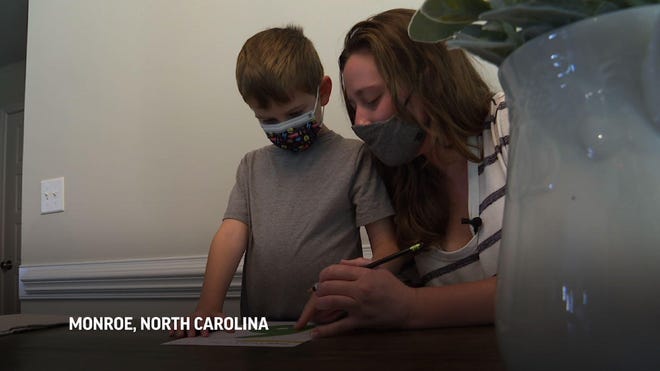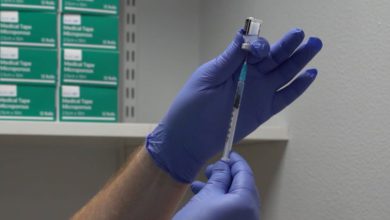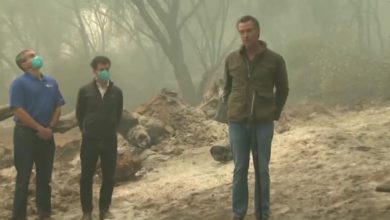
These days, few things are more upsetting to parents than getting the dreaded call: your child was exposed to COVID-19 at school, and they have to quarantine.
That means anywhere from seven to 10 days out of school. Besides disrupting a student's education, quarantines can upend parents' work schedules and even cause mental and emotional distress for kids and parents.
But who, if anyone, is actually enforcing these protocols?
More: 'Test & Stay' pilot program to end school quarantines begins Tuesday at Mason High School
School officials themselves cannot legally enforce quarantine or isolation, but districts often aid in – or, lately, carry the brunt of the work of – contact tracing. In theory, local health departments are the ones with the authority to contact trace, quarantine and isolate individuals exposed to a deadly, contagious disease.

But COVID-19 has become too big for health departments to handle on their own, leaving lines blurry when it comes to enforcement.
Take Dublin City Schools, for example. School officials said if a child shows symptoms at school, parents are called to pick up the student and told to quarantine for seven days with a negative test or 10 days without a test, under Franklin County Public Health's requirements derived from the Ohio Department of Health's guidance.
“If a parent refused to keep their child home, we reach out to Franklin County Public Health for further direction,” the district said.
But Franklin County Public Health would not provide information about what happens if a student refuses to abide by their quarantine rules.
Health departments across the state don't seem to have any procedures in place to deal with noncompliance when it comes to quarantine.
“Failure to comply would likely fall to ODH to enforce,” Joseph Ebel, Fairfield County Department of Health commissioner said.
The state health department, though, said it holds no authority to enforce local health departments' requirements. It doesn't track school quarantines, either; just COVID-19 case numbers by district. Finally, the data is incomplete as many districts across the state fail to submit weekly case numbers.
"To clarify, local health departments, not the Ohio Department of Health, enforce quarantine orders," Alicia Shoults, spokesperson for the Ohio Department of Health, said.
"If voluntary compliance cannot be obtained, children or staff shall be excluded from in-person school and school activities, based on the quarantine order of the local health department," Shoults said, citing Ohio law. These laws give "local health departments the legal authority to step in to enforce quarantine if an individual will not voluntarily comply."
Legally that might be true. But in practice, local health departments do not have the bandwidth to enforce their own protocols.
"Technically it is against the law for individuals to knowingly defy quarantine or isolation orders," Interim Butler County Health Commissioner Michelle Burch said. "We as a health department are not a law enforcement agency. So that would be, truly, the responsibility of a prosecutor."
Burch said her department has yet to need the assistance of the Butler County prosecutor's office to help with quarantine compliance. There haven't been any referrals to the Hamilton County Prosecutor's Office for quarantine enforcement either, officials said, though the office would work "closely" with the local health department "should an issue arise."
Officials with the Cuyahoga County Prosecutor's Office, on the other hand, said they would not deal with noncomplying individuals at all.
"Our office has no legal authority over an individual refusing to quarantine or isolate upon coming into contact with COVID-19. Refusing to quarantine is not a felony offense," Cuyahoga County Prosecutor's Office communications specialist Lexi Giering said.
In lieu of legal interference, at least at the K-12 level, some school administrators are stepping in as quarantine enforcers.
"If a quarantined student comes to school, they would not be allowed to attend class and would need to wait in the office until a parent or guardian comes to pick them up from school," said Betsy Fuller, community relations director for Lakota Local Schools in Butler County.
Bottom line: schools, local health departments, prosecutors, the state and the community at large are relying on individuals to, well, do the right thing, and stay home if they're sick.
How is the requirement supposed to work?
The Ohio Department of Health has optional quarantine guidance and a flowchart for schools and local health departments, which most counties have implemented as law during the pandemic. Experts generally agree that it is of utmost importance to keep as many healthy children involved in in-person learning as possible.
More: What are the steps to take if you've been exposed to COVID-19 in schools? What Ohio, CDC recommends
Schools with universally enforced masking, social distancing and other COVID-19 prevention policies in place do not generally have to quarantine students at home, per the policy, as long as those protocols are followed. Unvaccinated, unmasked students or teachers do have to quarantine if they come in contact with an infected individual.
Those individuals told to quarantine must do so for seven days if they receive a negative viral PCR or antigen test at least five days after exposure, or for 10 days without a test.
More: The difference between COVID-19 tests, and which one you should take
Any student who tests positive for the virus is required to isolate at least 10 days from the date of the positive test.
Sometimes, though, families are not made aware of their close contact status in time for a proper quarantine. Corey Hamilton, Zanesville-Muskingum County Health Commissioner, said her department typically tries to contact families within 24 hours of learning a student was exposed to the virus.
"However, since school started we have had a surge of almost 950 positive cases associated with schools," Hamilton said. "If you consider that each case may have 5-10 close contacts, it takes some time for us to reach everyone."
Despite the challenges, school districts and local health departments across the state say their partnerships with one another have been invaluable in getting through the pandemic so far.
"(The health department) has the responsibility to issue quarantine orders to close contacts that are identified. Schools have the responsibility to exclude those with a quarantine order from school and school-based activities. It's a shared responsibility and requires a good partnership with the schools," Hamilton said.
The real consequence: Further spread of the virus
In the end, those who do not follow best practices regarding quarantine and isolation run the risk of further spreading COVID-19, which so far has infected more than 43 million Americans and killed nearly 700,000, according to the Centers for Disease Control and Prevention.
“Contact tracing and quarantine are techniques that public health practitioners have used for over 100 years to control and stop the spread of communicable diseases,” Franklin County Public Health communications specialist Amber Breedlove said. “If contact tracing and exclusions are not made within the current guidance, the spread of COVID-19 will continue. More individuals will be exposed and become sick. Some will be severely sick, which will lead to hospitalization, long-term health effects and unfortunately death.”
Health experts have consistently advised the best practices to prevent contracting or spreading the virus are getting vaccinated against COVID-19 and wearing a face covering.
"We are expecting the citizens of our county, in good faith, to just do their part," Butler County's Burch said. "We are trying to limit COVID-19 as much as we can. So we're expecting the public to do what they need to do: get vaccinated, wear the mask, stay home if they're sick (or) been exposed to someone (with the virus)."
Source link









